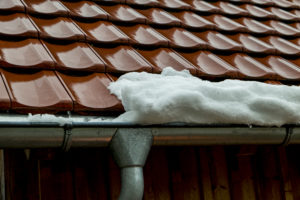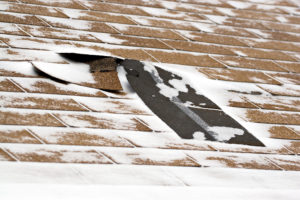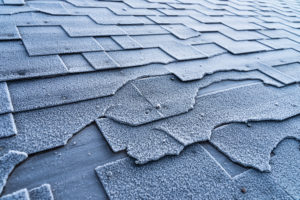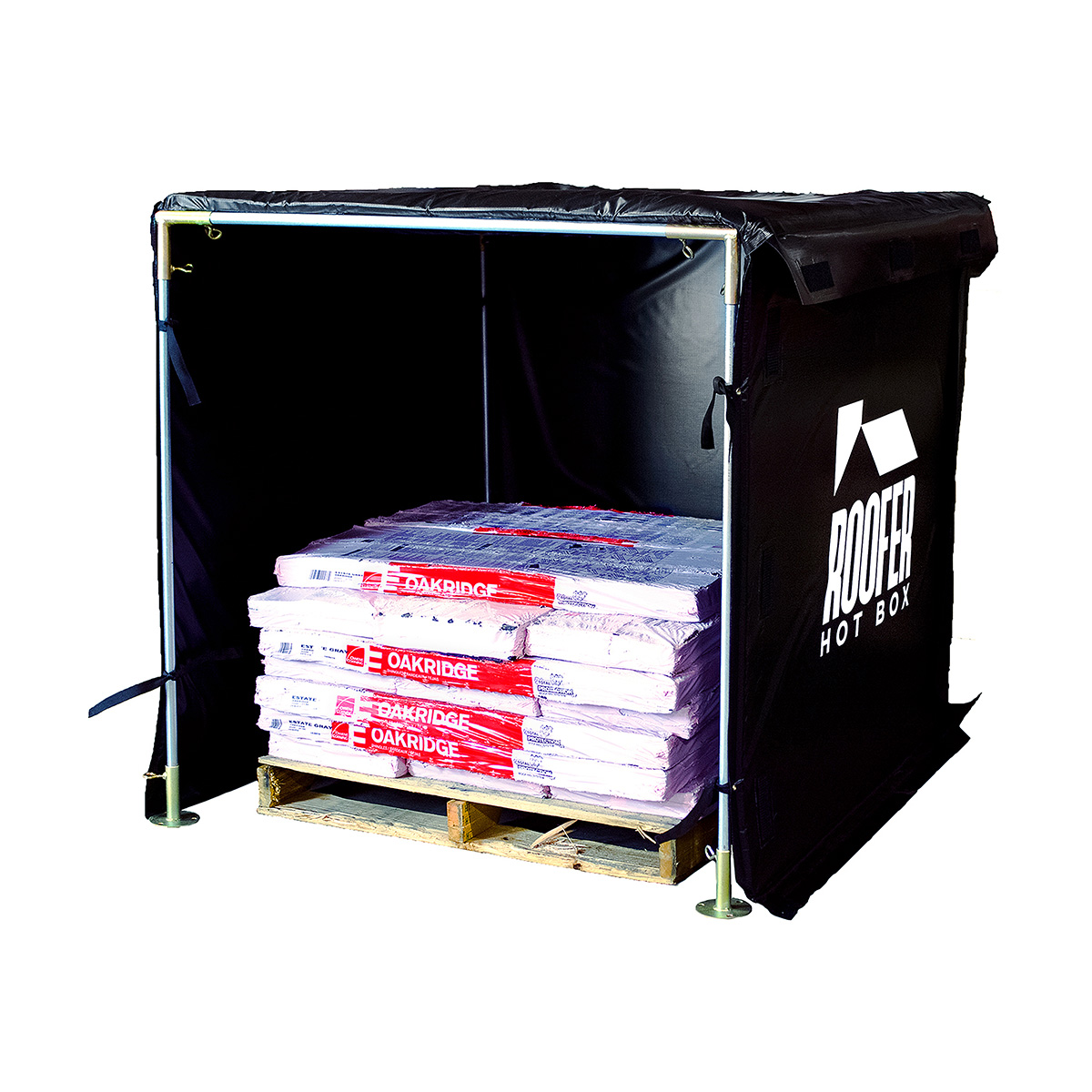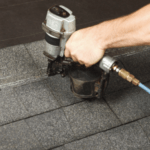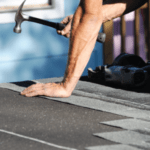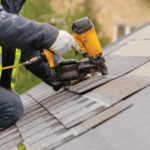Challenges with Roof Repair in Winter
Roof repair in the winter season can be challenging due to harsh weather conditions. For example, roofing materials can become brittle in cold temperatures, making manipulating and installing them challenging, especially for the most common shingle roofs. Also, snow and ice can create hazardous conditions for roof repair workers, potentially making it difficult to access and work on the roof. In addition, traditional methods of thawing frozen roofing material can be slow and ineffective, further adding to the difficulties of cold-weather roof repair. These factors can result in increased repair times and costs, making it imperative for contractors to effectively overcome the challenges associated with roofing in the winter season.
Ice Dams:
One of the most common problems during winter is ice damming. Ice dams occur when snow on the roof melts and runs down to the roof’s edge, where it refreezes and builds up, creating a dam that blocks the flow of water. The trapped water can then seep under the shingles and into the home, causing damage to the roof and interior. This can be more likely on a flat roof as they are more likely to hold water when snow and ice melt.
Brittle shingles:
Shingles can become stiff and brittle in the cold, making them more prone to cracking and breaking. This can result in leaks and allow water to penetrate the roof, causing damage to the roof deck and other parts of the home.
Roof Leaks:
Roof leaks can be caused by a variety of factors, including ice damming, damaged or missing shingles, poor flashing, and clogged gutters. If not addressed promptly, these leaks can cause significant damage to the roof and interior of the home.
Poor Adhesive Properties of Asphalt Shingles:
Asphalt shingles have poor adhesive properties in cold weather, which can make them less effective in preventing leaks. If the adhesive is not properly applied, the shingles may come loose and allow water to penetrate the roof.
High Wind Speeds:
High winds during winter can cause significant damage to roofs, especially in areas prone to strong storms. They can cause shingles to come loose, rip off, or break, exposing the roof deck and creating a pathway for water to enter the home. Additionally, high winds can also cause damage to chimneys, skylights, and other roof penetrations, leading to leaks and other problems.
What are short-term winter fixes?
If you experience roof damage during winter, it is important to take quick action to minimize further damage and prevent potential safety hazards. Often people wait for a permanent repair solution to be addressed in the spring; a few short-term fixes can be done to keep your roof intact until then.
One standard solution is to cover the damaged area with a tarp. This will provide temporary protection from the elements and prevent water from entering your home. Secure the tarp in place so it doesn’t blow away in strong winds.
Another short-term fix is to apply a sealant to cracks or holes in the roof. This will help to prevent water from seeping through and causing further damage. Look for a sealant designed for roof repair, and apply it according to the manufacturer’s instructions.
If you have missing shingles, you can replace them temporarily with metal flashing. This will provide a barrier against water and wind until a permanent repair can be made.
It is important to remember that these are only temporary fixes and that a professional roof repair is still needed in the spring. Don’t wait to address roof damage, as it can quickly escalate into a bigger problem if left unattended.
Finding Advice You Can Trust: Things Roofers Must Consider With Winter Roof Repairs
Taking Extra Care in Winter Roofing Work
For cold-weather roofing, roofers must get the right advice and information. With the unique challenges of winter weather, it is important to have a solid plan and strategy in place. Here are a few things that roofers should consider when conducting roof repairs in winter:
Firstly, roofers should consult with reliable sources and industry experts to stay informed about the latest technique and roofing products available for winter roof repair. This will ensure they use the most effective and efficient methods to address the problem.
Secondly, roofers should be aware of the hazards of winter roof repair, such as slippery conditions and ice damming. They should take appropriate safety measures to prevent accidents and ensure the repair is completed safely and effectively.
It is also important for roofers to consider the types of materials and the specific challenges associated with each one. For example, some products may be more difficult to work with in winter or require special techniques to ensure a fast repair.
Finally, roofers should take the time to properly diagnose the problem before starting the repair. This will help ensure the repair is done correctly and minimize the risk of further damage.
In conclusion, finding the right advice and information is crucial for roofers conducting winter repairs. By staying informed and following best practices, they can ensure that the repair is done quickly, safely, and effectively and that their client’s roofs will remain protected through the winter months.
Special Materials for Roof Repairs in Winter
Winter storms and extreme weather can come unexpectedly and sometimes earlier in the season or later than expected. When these storms arise, it puts most roofing projects on hold. This makes roofing companies lose time, money, and the potential product should some be damaged. Don’t be one of those roofing contractors caught without a solution when bad weather hits. Continue reading to learn more, or jump over to our Cold Weather Roofing Calculator to see how you can best utilize these tools.
Special materials are essential for effective winter roof repair. For example, using a sealant specifically designed for different temperatures can help ensure that the repair is long-lasting and effective. In addition, using flexible materials can help prevent cracking and breaking in winter. Powerblanket bulk material warmers can change the game for winter roofing by providing a reliable solution for heating and maintaining the temperature of these special materials. By keeping materials at the optimal temperature, Powerblanket bulk material warmers can help prevent issues such as improper curing, adhesion failure, and product separation, ensuring that the fix is done correctly and effectively. The warmers are also easy to use and easily transported to the job site, making them an essential tool for roofing professionals.
Proper Shingle Sealing
Another special tool you can add to your arsenal as a roofing contractor is Powerblanket bucket heaters. Keeping adhesive at the proper temp for effective application can be difficult in low-temperature roofing jobs. This is where Powerblanket bucket heaters can play a significant role. These heaters can keep adhesive at a usable viscosity, allowing for proper shingle sealing. By maintaining the temperature of the adhesive, Powerblanket bucket heaters ensure that the adhesive remains pliable and easy to work with. This helps to eliminate issues such as improper curing and adhesion failure, leading to a more effective fix. The heaters are also designed to be easy to use and easily integrated into the roofing process, making them a valuable tool for any low-temperature roofing project.
Best Environment for Roof Replacement
The best environment and conditions for roofing vary depending on the type of material used and the job site’s specific conditions. It would be easy to assume that winter months are not great for roofing, and warmer weather is ideal. However, warm and dry conditions are generally ideal for roofing projects.
Warmer weather helps ensure the products remain pliable and easy to work with. This is particularly important for asphalt shingles, which have poor adhesive properties when cold and can become stiff and brittle in low temperatures. In addition, warm temperatures also help promote proper curing and adhesion, which is essential for a long-lasting and effective roofing repair or installation.
Dry conditions are also ideal for roofing projects as they help prevent moisture-related problems such as mold and mildew growth and promote proper adhesion of roofing materials. That’s why the moisture left when snow melts can cause more problems. In addition, dry conditions help prevent rain and other precipitation from interfering with the roofing process, which can cause delays and other issues.
While warm and dry conditions are ideal for roof repairs, using bulk material warmers and bucket heaters can still allow you to complete your roofing job. However, it is essential to take appropriate precautions to ensure that the roofing material and equipment are protected from the elements and that the roofing process is carried out safely and effectively. For example, using specialized materials and equipment, such as Powerblanket bulk material warmers or bucket heaters, can help keep the roofing materials at the optimal temperature and prevent issues such as improper curing and adhesion failure.
Frequently Asked Questions
Is roof repair covered by home insurance?
Roof repair is typically covered by homeowners insurance if the damage results from an act of nature or a sudden accidental event, but not if it's due to wear and tear or neglect.
How much should a minor roof repair cost?
Minor roof repairs can range from $150 to $1,500, depending on the extent of the damage and labor costs, which usually fall between $45 and $65 per hour.
How to fix a leaky roof in winter?
To fix a leaky roof in winter, it's best to temporarily cover the damaged area with a tarp or apply a sealant until a professional can perform a permanent repair in safer conditions.
What temperature is too cold to replace a roof?
Roofing projects are generally advised against when temperatures drop below 40 degrees, as cold conditions can affect the pliability and adhesion of roofing materials.
The Powerblanket Hot Box is the perfect solution for your bulk material heating needs.


